Equipment
The Economics of Choosing CCR Vs OC
How many “deep” open circuit dives would you have to conduct—you are using helium aren’t you?—to pay for a rebreather, training and necessary experience dives? It’s question that instructor evaluator Guy Shockey explores in detail in his analysis of the economics of rebreather versus open circuit scuba. Ironically, shortly before this article posted, the author informed us that helium prices in Western Canada had risen again and availability was limited. The result, explained Shockey, is that the number of dives to break-even is likely down 25%, or about 39 dives compared to 52 dives as calculated in his story. Welcome to what the gasworld magazine calls it, “Helium Shortage 4.0.” Time for InDEPTH’s Holiday Rebreather Guide!
By Guy Shockey. Images by Andrea Petersen unless noted.

I teach both open circuit and closed circuit Global Underwater Explorers (GUE) technical diving courses, and I am frequently emailed or messaged from students who have completed their Technical Diver 1 (Tech 1) course and fulfilled their experience requirement for further training. They ask me for advice as to whether they should move forward with Technical Diver 2 (Tech 2) or start down the CCR pathway with Closed Circuit Rebreather Diver 1 (CCR 1).
There are several factors to consider when making this choice, but one of the biggest decisions concerns the relative cost of both pathways. The up-front cost of closed circuit rebreather (CCR) training appears considerable on the surface: you need to purchase the CCR and the associated parts and pieces to set it up as a GUE compatible system. I decided to do a little math and see at what point a diver would reach a break even point with their CCR purchase as opposed to conducting OC Tech 2 dives.
To compare apples to apples, I also needed to include both CCR 1 and Closed Circuit Rebreather Diver 2 (CCR 2). This is important because, while CCR 1 will get you the knowledge and training to do your CCR 1 dives in the T1 range (max depth 51 m/170 ft w/30 minutes of deco), you will need CCR 2 training to move into the Tech 2 range (75m/250 ft with 60 min of deco).
Costing Out The Options
I started with the actual cost of training, and for me, a Tech 2 class costs $2250. When I calculated the gas costs of a Tech 2 class, I used $1.75 cu ft of 21/35, $1.95 cu ft for 18/45 and $2.15 cu ft for 15/55. This could be much lower than in many places, and these costs are not going down. A typical Tech 2 class with me will see a 45 m/150 ft dive followed by a 60 m/200 ft dive and then a 75 m/250 ft dive. These depths and the times may vary from instructor to instructor, but this is likely a good starting point.
With the volumes of the various gasses needed, adding three charters for the experience dives, and assuming the class had three students, so the instructor’s charges would be split three ways, I came to an amount just shy of $5,350 for costs needed to complete a T2 class.
In comparison, I then did the same calculations for a CCR 1 class. This included doing some quick math with respect to the cost of the actual CCR unit itself. This is usually the big “Holy Smoke” factor for divers choosing between T2 and CCR 1. The JJ-CCR itself is about $9,000, and then you need to add in the parts and pieces to make it GUE compatible, and by the time the smoke clears, you are looking at about $11,500. [Ed.Note: At the present time, GUE only offers courses on the JJ-CCR in a special GUE configuration.] I assumed you would repurpose your OC regulators that you would have used in your Tech 2 class, so that portion of the costs are a wash.
Class costs for a GUE CCR 1 class are the same as a Tech 2 class, but associated costs are considerably less. For this reason, the CCR 1 course fee and incidental costs come to $2,970, assuming that the student rents their CCR cylinders, or $2380 less than a Tech 2 class. Thus, your initial outlay to take a GUE CCR 1 class would be in the neighborhood of $14,470.
This means that your choice to take CCR 1 over Tech 2 would require an additional $9120.
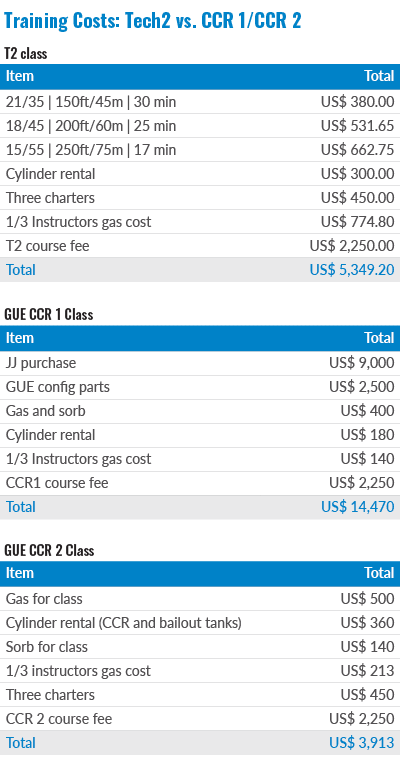
After your CCR 1 course, and 25 experience dives on your JJ-CCR, you will be diving your CCR unit into your original Tech 1 range, with a significant cost savings per dive. One of the biggest benefits of diving a CCR is that gas costs are not that different regardless of whether you chose to dive to 45m/150 ft or 75m/250 ft. This means that, if you wish, every dive can be a technical dive.
In order to compare apples to apples, I wanted to take this one step further and see what the economics were of taking the JJ CCR into the Tech 2 range. Remember that the original choice was CCR 1 or Tech 2, and stopping your CCR training at the CCR 1 level would not give you the knowledge or training to safely dive into the Tech 2 range. There are some significant considerations when moving from the normoxic to the hypoxic range of technical diving, and the CCR 2 class includes much of what was previously taught in Tech 2.
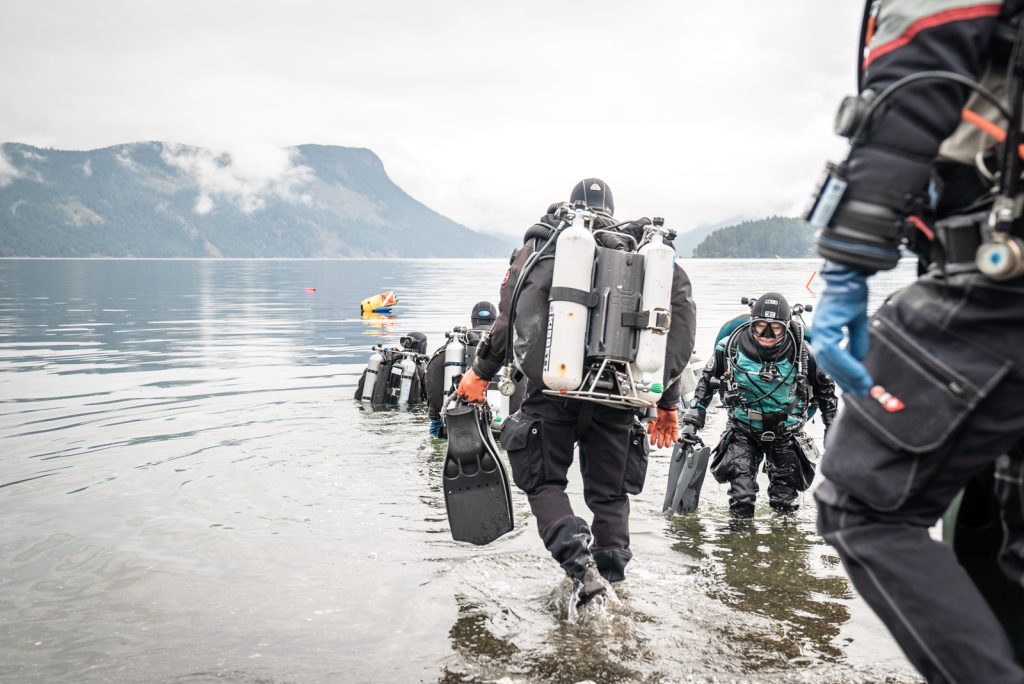
I have written about this before but, in a nutshell, if you have to bail out from a CCR 2 dive, you are then basically an open circuit Tech 2 diver, and you need all the same skills required as a Tech 2 diver, including bottle rotations. Hence the CCR 2 course is considerably more complex because it combines both open circuit and advanced closed circuit hypoxic dive training.
The prerequisite to CCR 2 training is the requirement to perform at least 50 CCR 1 experience dives with half of them in the Tech 1 range. The good news is that these dives are a lot less costly than an open circuit dive to the same range. Fifty of these dives will cost you about $260 per dive (assuming you need a dive charter and rent cylinders) so at the outside, you will spend $13,000 on these dives.
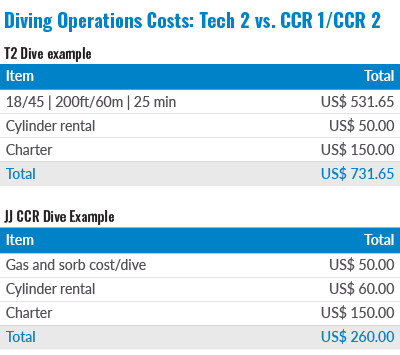
Now we need to add back in the cost of the CCR 2 course, and this training— including incidentals—will cost you in the range of $3913. Thus, to take your JJ CCR into the Tech 2 range, you will need the cost of the experience dives and the cost of the CCR 2 course. This will add an additional $16,913 to your initial cost difference of $9120 when you choose the CCR 1 over Tech 1 pathway. In a nutshell: you will need just shy of $26,033 more if you choose to move into the Tech 2 range. However, this would presumably be spent over a year or two.
This seems like quite a significant cost difference at first, and $26,03 is nothing to sneeze at for sure! However, now we need to start looking at what all your future diving is going to look like.
Using an 18/45 trimix dive to 60 m/200 ft as a baseline “standard T2 dive,” and using all the original costs and volumes I used to calculate the Tech 2 class, I calculated each Tech 2 dive as costing about $731. At the same time, the equivalent CCR 2 dive will cost you about $200, with potentially $60 cylinder rental (ccr and bailout bottles). When the smoke finally clears, you will save about $500 per dive if you do them on your CCR and it would take you only 52 dives to make up your original cost differential! [Ed: Total cost to achieve CCR2 ($31,383) less T2 class cost ($5349)÷ $500/dive] Moreover, since it will really cost you about the same to do a CCR 2 dive than a CCR 1 dive (excluding bailout cylinders), all 52 of these dives can be done exploring some pretty remarkable sites that are outside of the range of the vast majority of divers.
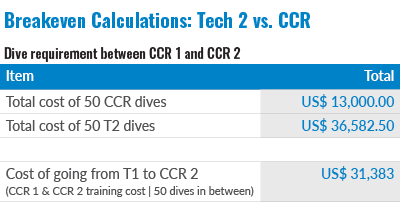
CCR v OC Calculations
Doing these calculations was quite enlightening. I knew that at some point, it would make sense to choose CCR over OC for technical diving, even given the higher costs to “buy in” to CCR training, but I didn’t honestly realize that the break even point for a diver who chose the CCR 1 and CCR 2 pathway as opposed to the Tech 2 pathway would need only 52 dives to make back their investment!
The assumptions used in the calculations shown above are here:
CCR v OC Calculations
There are a few other things to consider after your T2 or CCR 1 training also.
Other Considerations
As I mentioned above, one of the coolest things about CCR diving is understanding that your oxygen use is independent of depth. It is a function of your metabolism, and it doesn’t matter how deep you decide to dive. The only factor that needs to be considered with respect to depth is the amount of diluent you need for your loop volume, the amount of bailout gas you need, and drysuit inflation. What this means when the rubber hits the road, is that every dive can be a tech dive where you are exploring outside the limits of the recreational diving realm! For me, this was a huge consideration: I wanted to see what most divers were not able to see, and this meant diving past the normal recreational limits. Basically then, my de facto technical diving increased substantially because cost was no longer such a limiting factor. All my “fun” dives could be technical dives!
From a logistical point of view, unless you need to use your bailout deco gas, the only gas you will need to use there is what is wasted during gas analysis! This means that your bailout deco gas lasts a longgggg time! This also helps when it comes to, “How many cylinders do you need to carry on the boat?” You can do a lot more diving with fewer cylinders, and this is not something to ignore when talking about T2 level dives!
I live in the Pacific Northwest, and the water temperatures here can be challenging depending on the time of year. There is absolutely no question that I am warmer when diving on my CCR. The air I am breathing is warmer and is not as dry. I most definitely notice this and stay warmer in colder water.
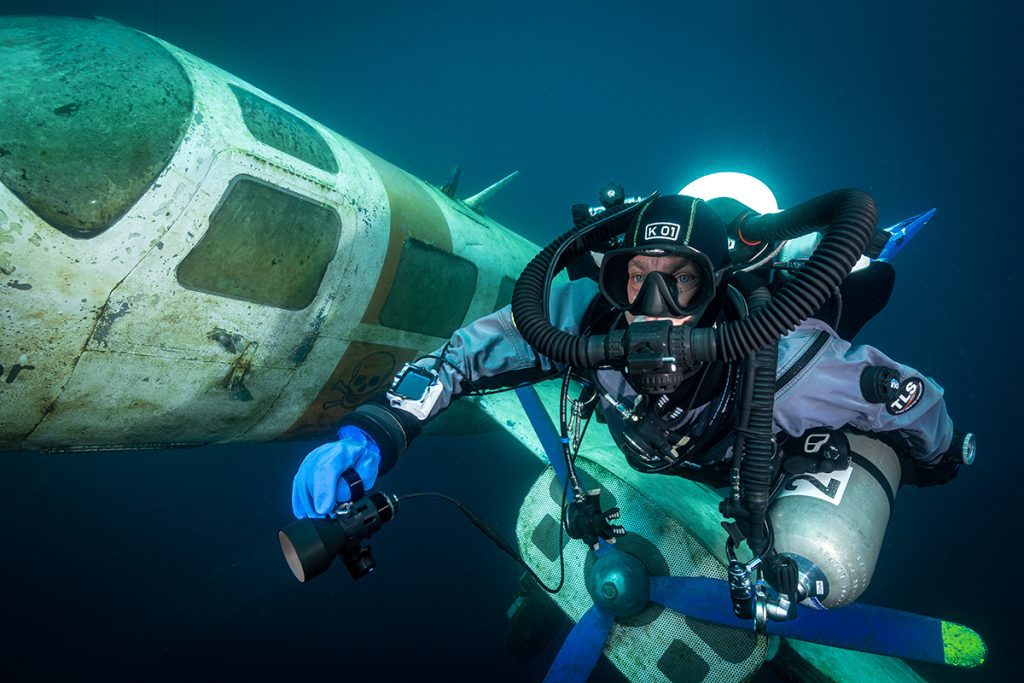
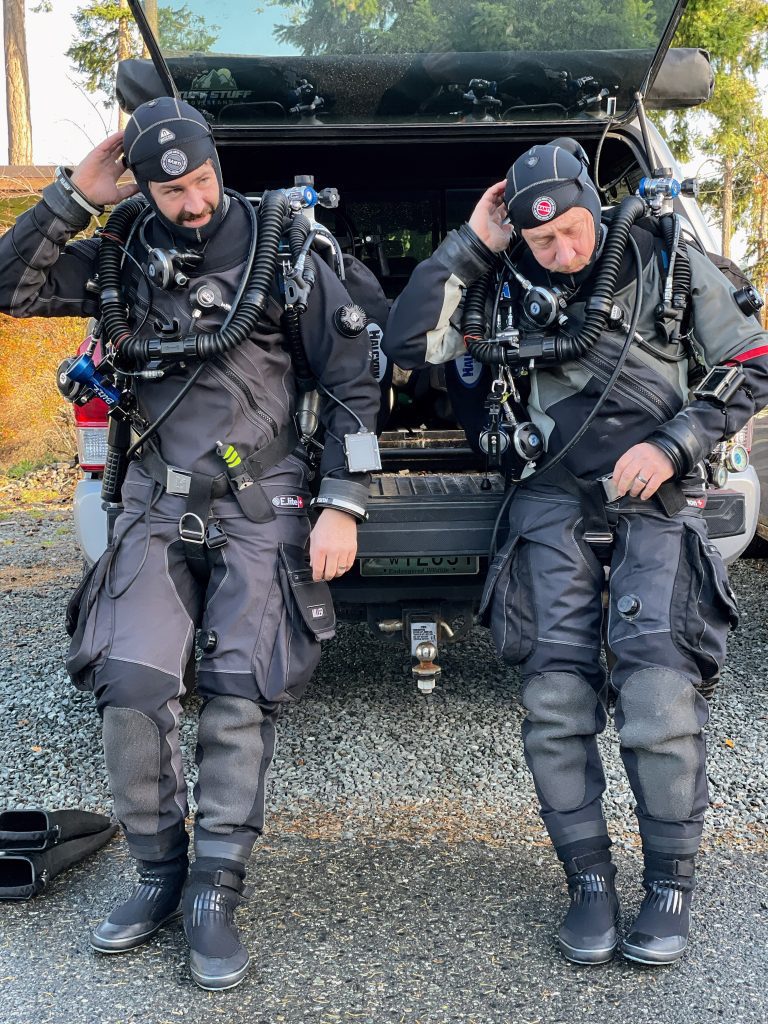
Is There a CCR In Your Future?
Helium costs continue to rise, and availability is becoming more of a problem every day. This means that the break even point continues to come sooner, and the follow-on costs become more significant. This means that in our current world, for those with a desire to explore in the technical diving range, the decision to choose the CCR 1/CCR 2 pathway versus the T2 pathway becomes more straightforward!
There are several things to consider when deciding whether to choose the CCR or OC pathway past T1. Costs, logistics, helium availability—now and in the future—are just part of this equation.
I think the CCR 1 pathway is likely the most pragmatic choice, but this requires a healthy initial investment and an understanding that you will likely need to complete CCR 2 down the road to have access to the deeper depths that T2 unlocks. There are a lot of considerations involved when entering the hypoxic gas realm and the associated skills required if things go sideways on these deeper dives. Frankly, I get a little nervous when I see divers moving into these deeper ranges with no CCR training specific to these depths. “You don’t know what you don’t know” is a very real consideration here.
CCR 1 is likely the way of the future. The benefits are clear, and it unlocks many aspects of technical diving that fit well with our GUE exploration world. I have personally seen an increase in CCR students after T1 and look forward to seeing our technical world grow and evolve!
To Be, or Not to Be a CCR Diver: How I made the Choice
InDEPTH asked new technical or CCR divers to tell us how they went about making the decision as to when and why to make the switch from open circuit. Here’s what they told us: To Be, Or Not To Be
Dive Deeper
InDEPTH: GUE and the Future of Open Circuit Tech Diving by Ashley Stewart
QUEST: CCR LEVEL 2 Enters The World by Guy Shockey
InDEPTH: The Thought Process Behind GUE’s CCR Configuration by Richard Lundgren
InDEPTH: Can Mouthpiece Retaining Straps Improve Rebreather Diving Safety? by Reilly Fogarty

Guy Shockey is a GUE instructor and instructor trainer who is actively involved in mentoring the next generation of GUE divers. He started diving in 1982 in a cold mountain lake in Alberta, Canada. Since then, he has logged somewhere close to 8,000 dives in most of the oceans of the world. He is a passionate technical diver with a particular interest in deeper ocean wreck diving. He is a former military officer and professional hunter with both bachelor’s and master’s degrees in political science. He is also an entrepreneur with several successful startup companies to his credit.





















































